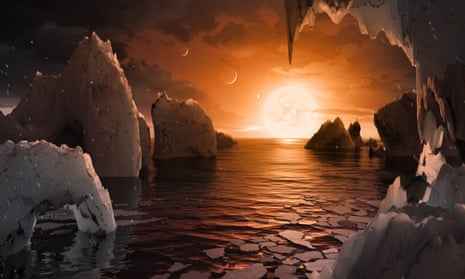Looked at in the right perspective, 39 light years is a trivial distance. In the imagination of science fiction writers it is only a hop and a skip away; even without faster-than-light travel, it is a distance that could conceivably be covered by a robot probe or even a colony ship. So the discovery that there are seven Earth-sized planets hurtling around a red dwarf star named Trappist-1 only 39 light years away, and that three of them may well have water oceans capable of nourishing life similar to that of primitive Earth, is deeply satisfying, as well as exciting.
What took them so long? There are already nearly 4,000 planetary candidates known from earlier surveys of the neighbouring stars. The number of stars in our galaxy alone is ungraspably huge: just the margin of error in one estimate is a figure with 11 zeros after it. If even one in a million had planets around it, that would still leave anything between 20m and 40m planetary systems in our galaxy alone. If none at all holds life, that would be completely astonishing. But if some have developed life, we are left with the question named after the Nobel-winning physicist, Enrico Fermi: where are they? Where are the aliens?
This is not just a question about alien life. It is also one about our own, and our place in the universe. It’s natural for any medium-sized omnivorous animal that evolved on Earth to be keenly interested in other life forms: will they eat us? Can we eat them? These urgent questions are coded into us through millions of generations of ancestors who managed to get the answers to both inquiries right. So versions of Fermi’s paradox – without his mathematical scaffolding – must have occurred to anyone who asked if anything was out there in the sky. Johannes Kepler’s early 17th-century novel Somnium, which has some claim to be the first science fiction ever written, peoples the moon with physical creatures. When Mars was thought capable of complex life, HG Wells had Martians invade us. To judge from the work of authors and even film-makers it is almost impossible for us to imagine a universe without conflict. If there are other species out there, their purposes towards us are unlikely to be benevolent, if they have any thoughts of us at all.
One obvious and sinister explanation for the fact that we have found no intelligent life in the universe is that it cannot develop beyond a certain stage without annihilating itself. No one can look at the possibilities for the coming century on Earth, encompassing catastrophic climate change on a planet packed with nuclear and biological weapons, and be entirely confident that we will make it through to the stage of development and maturity where we could start to physically explore the universe whose size and possibilities we now think we can grasp.
But it is a wonderful aim. The hunger for knowledge, and indeed for beauty, that pulls us to explore the worlds around us has a value in itself. In practice, even 39 light years may prove an unbridgeable distance. But the imagination that allows us to look at our galaxy from outside its spiral plane, and which has allowed us, here on Earth, to produce both the technology and the cooperation that makes scientific discovery possible, is the most valuable part of our species and the one we should trust to pull us outward into the wider unknown universe. To infinity – and beyond!
